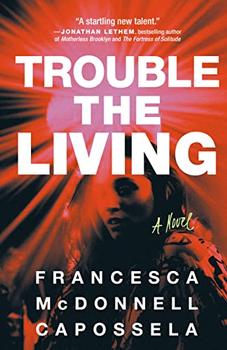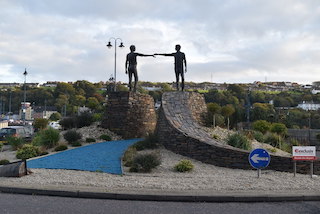Summary | Excerpt | Reading Guide | Discuss | Reviews | Beyond the Book | Read-Alikes | Genres & Themes | Author Bio

A Novel
by Francesca McDonnell CaposselaThis article relates to Trouble the Living
 Francesca McDonnell Capossela's novel Trouble the Living is in part set in Northern Ireland during the waning days of the Troubles, a 30-year period of violence brought mostly to an end by the signing of the Good Friday Agreement on April 10, 1998.
Francesca McDonnell Capossela's novel Trouble the Living is in part set in Northern Ireland during the waning days of the Troubles, a 30-year period of violence brought mostly to an end by the signing of the Good Friday Agreement on April 10, 1998.
In 1921, at the end of the Irish War of Independence, Ireland was partitioned into two self-governing territories: the predominantly Protestant Northern Ireland and the mostly Roman Catholic Irish Free State to the south. The Irish Free State was declared a Republic in 1949 and became an independent country (now called the Republic of Ireland), but Northern Ireland remained part of the United Kingdom.
Roman Catholics living in Northern Ireland experienced discrimination in employment, housing and other areas of life, and in the 1960s a civil rights movement sought an end to such inequitable practices. Tensions boiled over, and British troops were sent to quell the ensuing riots centered on the Northern Irish city of Belfast. The military presence, however, only inflamed the situation. The resulting period of turmoil came to be known as "the Troubles," and over the next 30 years more than 3500 people were killed in the violence.
Many groups espoused various forms of protest, but the largest and most active was the Irish Republican Army (IRA), which was responsible for the most violent attacks. In 1994, after years of preliminary negotiations between Northern Ireland's two primary nationalist parties, the IRA called for a ceasefire. Despite some setbacks (including a resumption of violence), multi-party talks between the governments of the UK, Republic of Ireland and Northern Ireland began in earnest in June 1996. U.S. President Bill Clinton also became heavily invested in the process and sent former senator George Mitchell to chair the talks. Representatives of Sinn Féin (the IRA's political arm) were excluded until 1997, permitted to join only after renouncing violence.
Negotiations, which went on for nearly two years, almost collapsed several times. Most intense was the final series of talks, from April 8–10, 1998. Delegates argued nearly non-stop for 58 hours, and Bill Clinton was on speed-dial 24x7 to lend his support. Mitchell set a deadline of midnight on April 9 for the representatives to reach an accord. The group was unable to agree in time but felt they were close, and so negotiations continued until the early hours of April 10: Good Friday. The agreement was signed late that afternoon, after seven hundred days of discussion and debate.
On May 22, 1998, in the first all-Ireland vote since 1918, the Good Friday Agreement was put before the voters of the Republic of Ireland and Northern Ireland. It was overwhelmingly approved, with support from 94 percent of Republic of Ireland citizens and 71 percent of Northern Irish.
The legislation's most significant provision was a recognition of Northern Ireland's complex identity, allowing residents to identify as British, Irish or both. The document further stated that Northern Ireland would remain a part of the UK until its population, along with the population of the Republic of Ireland, voted to join the Republic of Ireland. Checkpoints along the Northern Ireland border would be removed, and the British military presence would be scaled back. All armed groups agreed to disband, and people imprisoned for actions during the Troubles were to be released (a sore point to this day with those who were affected by violence).
Not everyone in Northern Ireland agreed with the provisions. The Democratic Unionist Party opposed it and campaigned against it. In addition, a splinter group of the IRA, the Real IRA, refused to give up their arms and eschew violence, continuing to commit acts of terror such as the Omagh bombing in 1998. Tall "peace walls" (many of which are still in place) were erected between Catholic and Protestant neighborhoods in some cities to minimize conflict. In addition, the Northern Ireland government has collapsed several times over its 25-year existence.
Still, there are signs of slow progress. As neighborhoods grow, the walls are being removed, and according to the 2021 census, Northern Ireland is now split relatively evenly between Catholics (45.7 percent) and Protestants (43.5 percent). A growing number of people also don't identify as unionist or nationalist, aligning instead with the non-sectarian Alliance Party. The partisan violence that defined the country for so long has, at last, mostly ceased.
"Hands Across the Divide" sculpture by Maurice Herron in Derry, Northern Ireland, photographed by N Chadwick (CC BY-SA 2.0), courtesy of Geograph
Filed under People, Eras & Events
![]() This article relates to Trouble the Living.
It first ran in the November 15, 2023
issue of BookBrowse Recommends.
This article relates to Trouble the Living.
It first ran in the November 15, 2023
issue of BookBrowse Recommends.
Your guide toexceptional books
BookBrowse seeks out and recommends the best in contemporary fiction and nonfiction—books that not only engage and entertain but also deepen our understanding of ourselves and the world around us.